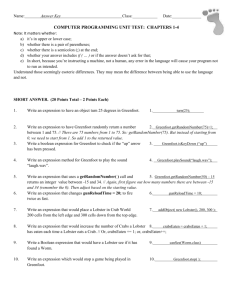
Chapter 1 greenfoot pdf software#
They present their work in this area-frame-based editing-and suggest possible future development options.Įducational software tools are nearly as old as programming as a discipline. The authors also discuss current developments, and suggest an area of interest where future work might be profitable for many users: the combination of aspects from block-based and text-based programming.

In this chapter, the authors describe their experiences with the design of three systems-Blue, BlueJ, and Greenfoot-and extract lessons that they hope may be useful for designers of future systems. New educational systems are currently being designed by a diverse group of developing teams, in industry, in academia, and by hobbyists.
Chapter 1 greenfoot pdf professional#
In the past, professional environments were often used in programming teaching with the shift to younger age groups, this is no longer tenable. With the rise of programming as a school subject in ever-younger age groups, the importance of dedicated educational systems for programming education is increasing. More systems of this kind have been published in the last few years than ever before, and interest in this area is growing. There are two separate new or revised statutes providing for these property tax exemptions, as follows: Section 196.AbstractEducational programming systems are booming. The Act also provides for potential exemptions from ad valorem taxation for properties that provide affordable housing units. If a municipality designates less than 20% of its land area as commercial or industrial, then the multifamily project must be mixed-use residential. The local government must consider reducing the minimum parking requirements described in its land development regulations if the project is within one-half (1/2) mile of a major transit stop, as defined in its land development regulations, and the major transit stop is accessible from the proposed development. The project must satisfy the local government’s land development regulations for multifamily developments, including regulations related to setbacks and parking and provided such regulations can be accommodated, and the proposed development must be administratively approved by the local government. Satisfaction of Local Government Land Development Regulations The multifamily building height for a qualifying project may not be restricted below the highest currently allowed height for a commercial or residential development located in the Local government within one (1) mile of the property or three (3) stories, whichever is higher. The local government may not restrict a qualifying project below the highest allowed density on any land within the local government where residential development is allowed. If the affordable housing is part of a mixed-use residential project, at least 65% of the project’s total square footage must be residential.Thus, all 40% of the affordable units could be provided at 120% AMI.


There is no requirement to accommodate any one, or combination, of the above AMIs. Affordable means that the monthly rents, including taxes, insurance and utilities, do not exceed 30% of area median income (AMI) for extremely-low-income persons (persons earning less than 30% of AMI), very-low-income persons (50% AMI), low-income persons (80% AMI), and moderate-income persons (120% AMI).

Stat., for a period of at least 30 years


 0 kommentar(er)
0 kommentar(er)
